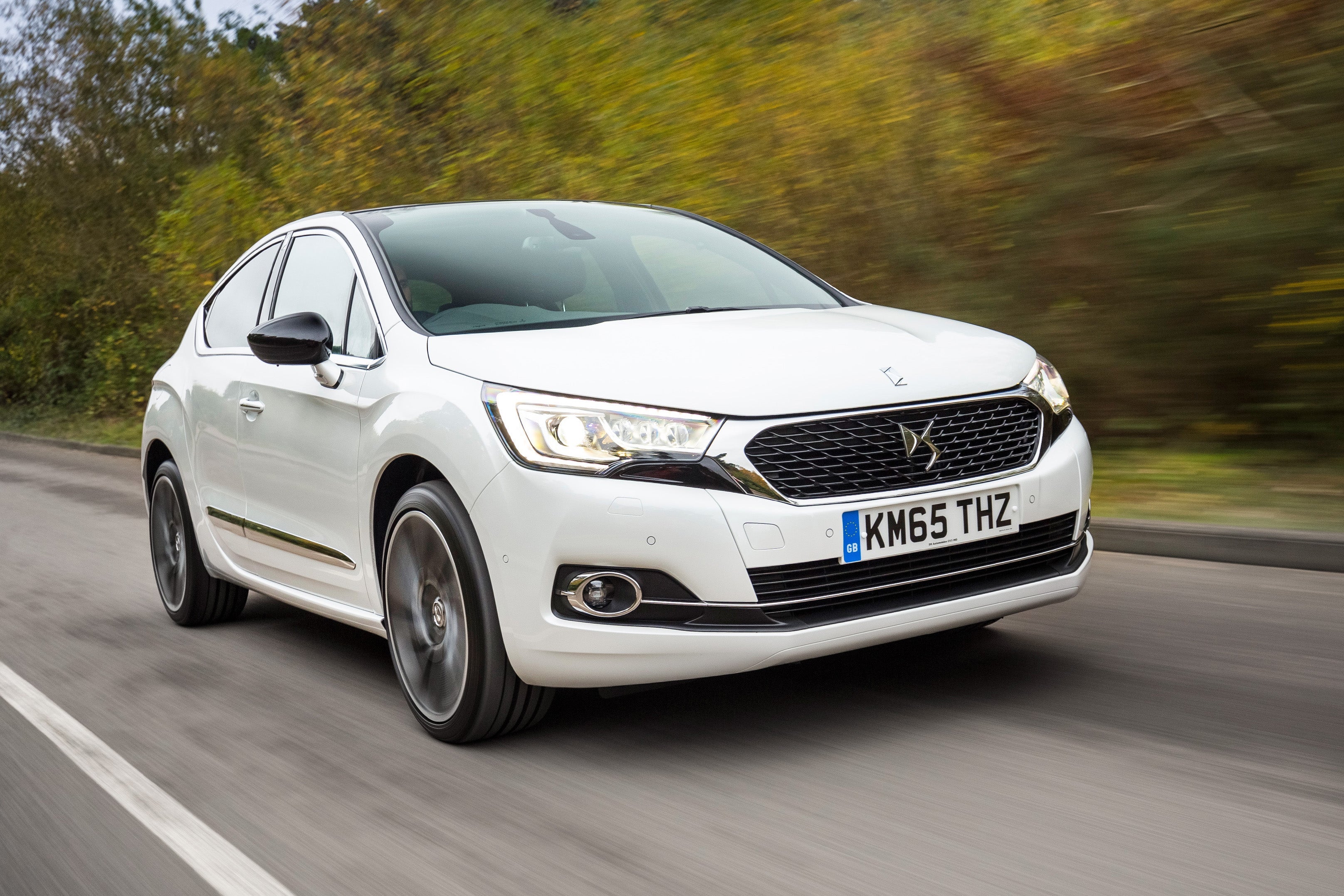DS 4 (2011-2018) Review
Written by Andrew Brady
Quick overview
Pros
- Upmarket cabin that’s loaded with neat details
- Premium looks, especially following the facelift
- Excellent level of standard equipment
Cons
- Early models look too much like a Citroen C4
- Poor practicality, especially in the rear
- Lacks dynamic sparkle
Overall verdict on the DS 4
"In this DS 4 review we are looking a car that doesn't fit neatly into any one box. The DS 4, coming from the premium-aspiring arm of Citroen, is a crossover with more than just SUV influence in its design and execution. The design is eye-catching and the interior is full of interesting details, while the specification is also strong. However, the driving experience is quite ordinary and it's not particularly practical for a car of this size, making it something of a left-field choice. "
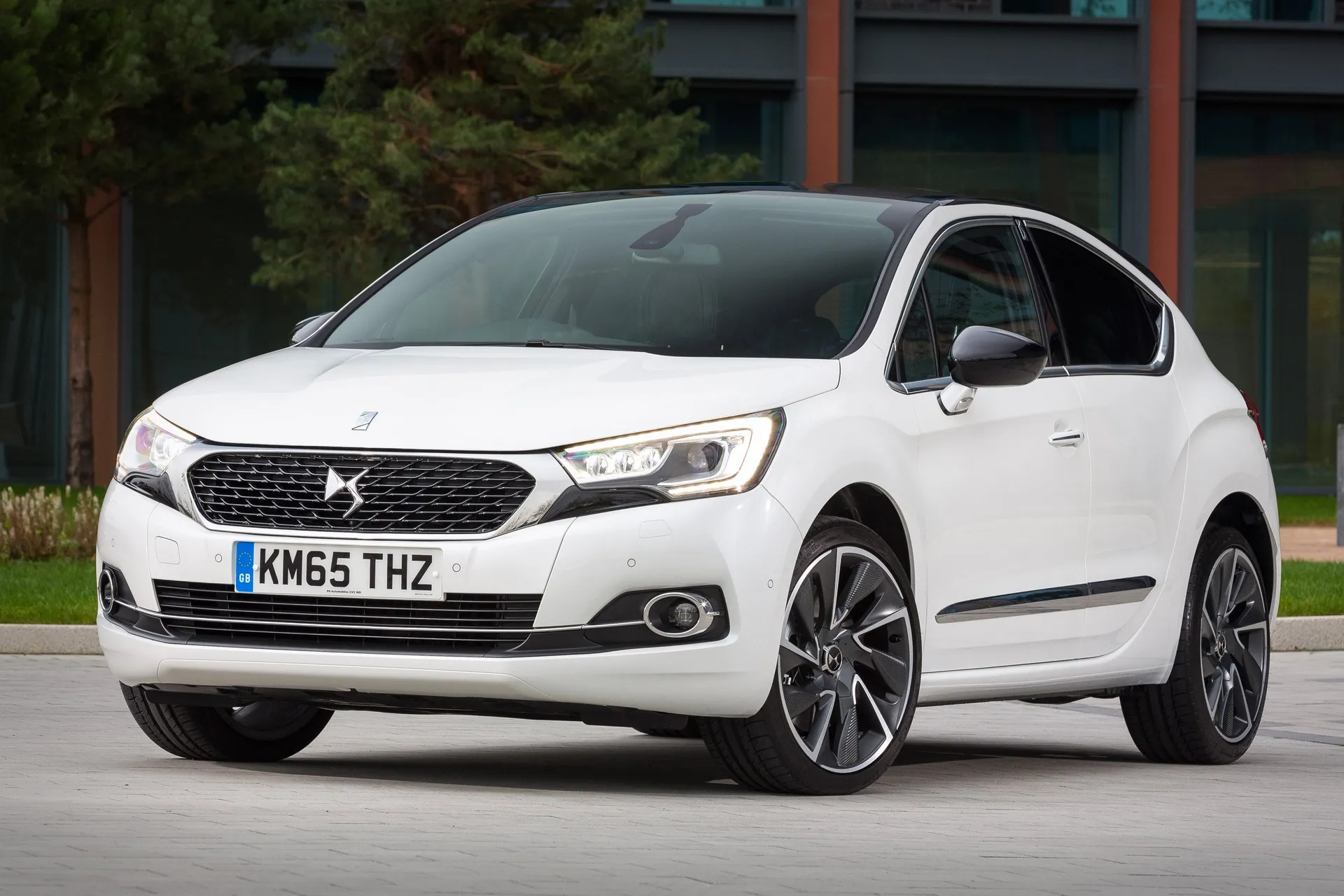
The DS 4 arrived in 2011 as the Citroen DS 4, before the Citroen name was ditched when the DS Automobiles brand flew the nest. Citroen hoped it would appeal to a broad spectrum of people, stealing sales from the likes of the Volkswagen Scirocco, Volkswagen Golf and Nissan Qashqai. It’s part-coupe, part-hatchback and part-crossover.
A jack-of-all-trades or a master of none, then? A bit of both, to be honest, but this isn’t necessarily a bad thing. The DS 4 is at its most convincing following the rebrand in 2015. Although it’s fundamentally the same car, the revised styling creates a gap between the DS 4 and the mainstream Citroen C4, while the level of specification went up a notch.
Whether you opt for the Citroen or the full-fat DS, you’ll discover a cabin that’s good enough to grace a car with an established premium badge. The architecture of the C4 remains, but the designers deserve great credit for creating something that looks and feels a class above the standard car.
Key to this is the use of premium materials and ambient lighting, as well as extra measures introduced to cocoon the cabin from the engine bay and the outside world. Opt for one of the top trim levels, or splash the cash on the richest leather, and you’ll be living the DS dream.
It’s not perfect. Although the DS 4 offers more luggage capacity than the Volkswagen Golf, the rear-seat accommodation is comically poor. Adults will find little room for their knees, and if this isn’t enough, the fixed rear windows don’t open. Fine in a coupe, but unacceptable in a five-door hatchback.
More positive is the range of engines on offer, including some efficient diesels, punchy petrols and a 1.6-litre turbocharged unit offering hot hatchback levels of performance.
Unfortunately, the DS 4 can’t quite decide what it wants to be. It lacks the comfort of a traditional crossover and the precision of a coupe or hatchback. It’s not bad to drive, but it never really excels at anything. The best version is arguably the DS 4 Crossback. Introduced in 2015, the raised ride height offers improved ride comfort without ruining the handling characteristics. It feels like the model that stays true to the DS brand promise.
In reality, there was only so much DS could achieve by using a Citroen C4 as a platform. Is it worth the small premium over the C4 on the used car market? We think so, not least because the cabin feels like a class act. It’s also a little different to the established names in the premium car market. There’s a lot to be said for going your own way.
If you're looking for the newer version, you need our DS 4 (2022) review.
Is the DS 4 right for you?
Does the DS 4 offer the best of both worlds or is it a case of mixed messages? Although the posh makeover of the humdrum Citroen C4 isn’t quite up to ‘Cinderella’ standards, this is a far more attractive car than its ugly sister.
This is especially true following the DS makeover, with the new styling helping to widen the gap between the posh DS 4 and the Citroen C4. Throw into the mix an upmarket cabin, a decent level of standard equipment and a range of efficient engines, and you have the makings of an excellent car.
Ultimately, the DS 4 is three cars in one: coupe, hatchback and crossover. It can’t rival the class leaders in any of these segments, but if you’re after a good all-rounder, the DS 4 is a convincing alternative.
What’s the best DS 4 model/engine to choose?
We’d favour a DS Automobiles version over the Citroen, not least because the refreshed styling creates a gap between the DS 4 and Citroen C4. You also get an improved level of standard specification and revised trim levels.
Even the entry-level Elegance trim offers a generous level of standard equipment, but we’d opt for the Prestige model, not least for the leather upholstery, LED/xenon headlights, 18-inch diamond-cut alloy wheels and reversing camera.
Unless you spend most of your time on the motorway, we’d recommend the 1.2-litre PureTech 130 engine. It offers the best blend of performance and economy, and isn’t hamstrung by the EAT6 automatic transmission that’s mated to the more powerful THP 165 engine.
A quick word about the 1.6-litre turbocharged engine that was available in the Citroen DS 4 and earlier versions of the DS 4. The BMW-sourced THP 200/210 unit is a peach, offering hot hatchback levels of performance.
What other cars are similar to the DS 4?
Citroen referenced the Volkswagen Scirocco, Renault Megane Coupe, Volkswagen Golf, Honda Civic, Nissan Qashqai and MINI Countryman when it unveiled the DS 4 in 2011. Part-coupe, part-hatchback, part-crossover, then?
Not quite, because it lacks the styling and dynamics of the Scirocco, the practicality of the Golf and Civic, and the raised ride height of the Nissan Qashqai. There’s only so much you can do when you’re basing a car on the Citroen C4. We’d place the DS 4 alongside the Nissan Juke in terms of practicality, although the cabin quality edges it tantalisingly close to the BMW 1 Series and Audi A3.
Comfort and design: DS 4 interior
"The interior of the DS 4 looks like the Citroen C4 wandered into a French boutique and filled a tote bag with expensive trinkets and glitter. It retains the same architecture as the Citroen, but the makeover creates something that feels more premium."
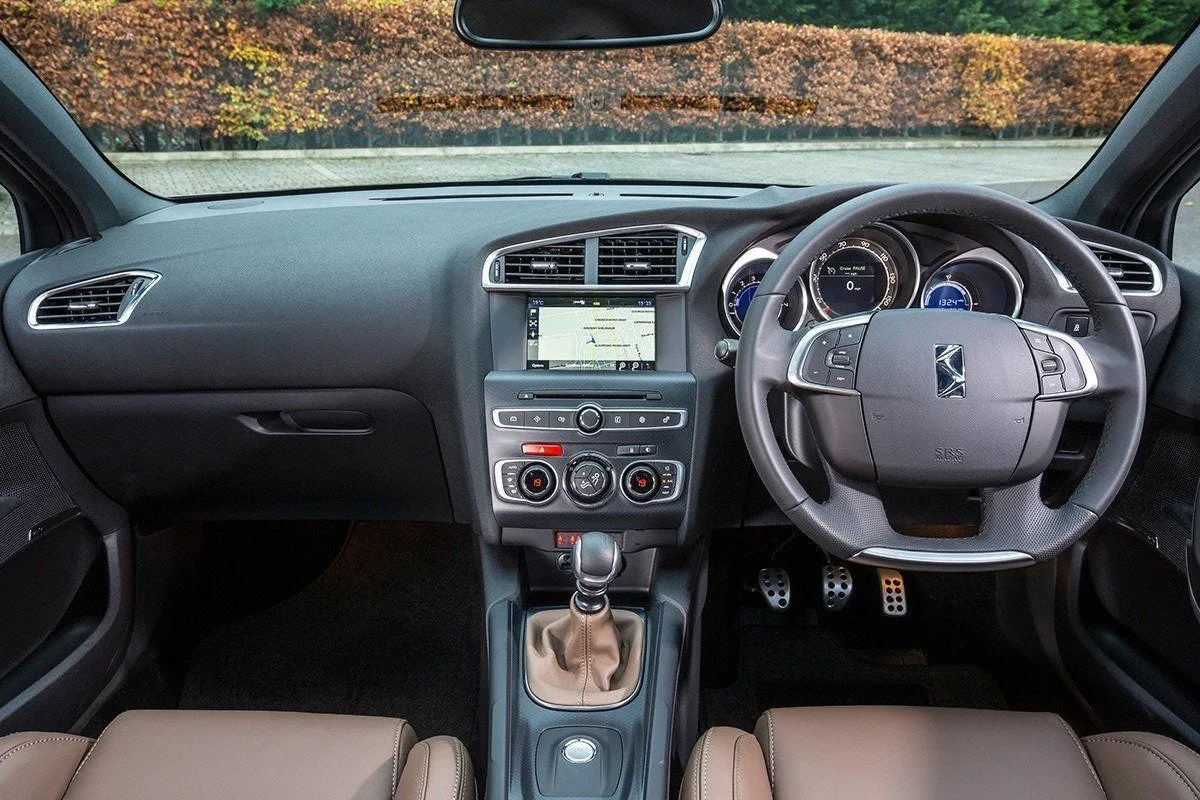
Citroen had visions of muscling in on the market dominated by BMW, Audi and Mercedes-Benz when it launched the DS 4 in 2011. It got very close to achieving this, using extra soundproofing, upmarket materials and lighting to create a comfortable cabin and a dashboard design that’s easy on the eye.
It lacks the raised ride height of a traditional crossover, but it’s worth noting the subtle differences between the three models. The original Citroen DS 4 did sit higher, but was lowered when the DS 4 arrived in 2015. That’s because the DS 4 Crossback was launched as a standalone model, featuring a ride height raised by 30mm.
Got that? Good, then we’ll continue. The seats are excellent, with lumbar adjustment standard across the range. Some models also feature electric lumbar adjustment with a massage function, which helps to while away the hours behind the wheel.
However, it’s the use of materials that truly impresses. The Nappa leather seats look and feel excellent, while the ‘watchstrap’ leather with DS embossing is a class act. DS claims every piece of leather used inside the DS 4 goes through a 21-hour process to look, smell and feel right. It shows.
Quality and finish
Although the DS 4 is essentially a dressed-up Citroen C4, it feels a class or two above the mainstream hatchback upon which it’s based. It’s amazing what some soft-touch plastics, ambient lighting and additional soundproofing can achieve.
Additional sound insulation under the bonnet helps reduce engine noise and vibration, while the windscreen is laminated with damping film. The floor is fitted with special soundproofing elements, the doors feature upgraded seals, and the entire cabin structure was sprayed with a special damping solution. Even the air conditioning and automatic handbrake are quieter in the DS 4 than in the Citroen C4.
Most of the materials are excellent, with the one-piece dashboard swathed in soft-touch plastic. The key touchpoints, including the interior door handles, shift lever, heating controls and steering wheel feel upmarket and plush.
Only some of the plastics used for the lower part of the cabin feel cheap to touch, but this is common for most cars. Although the leather upholstery delivers the greatest sense of occasion, the premium cloth upholstery in the Performance Line deserves a mention. The sport seats, steering wheel and gearstick gaiter are finished with neat coloured stitching, which looks superb. It also proves that you don’t need leather to create an upmarket feel.
Infotainment: Touchscreen, USB, nav and stereo in the DS 4
The seven-inch touchscreen infotainment screen is set back within the centre console, which looks a little dated when many cars feature high-gloss, flush-fitting screens. However, this is a minor niggle, not least because the screen is surrounded by classy materials.
We’d recommend the post-facelift version, not least because it saw the introduction of Apple CarPlay. Pub fact: the DS 4 was the first car in the PSA Group (Peugeot, Citroen and DS) to get Apple CarPlay connectivity. Although Android Auto isn’t available, syncing of Android smartphones is available via MirrorLink or the standard-fit Bluetooth.
The non-Citroen version of the DS 4 also has 12 fewer buttons on the centre console, which helps to improve the look of the dashboard. Furthemore, a USB socket became standard across the range, whereas it was optional on the old DSign trim, but standard on the DStyle and DSport.
A Denon premium sound system upgrade is available, comprising a digital amplifier, four woofers, four tweeters and a boot-mounted subwoofer. It’s a great system, although it robs you of 26 litres of boot space. A small sacrifice for an enhanced audio experience?
Space and practicality: DS 4 boot space
Let’s start with the positives. The boot in the DS 4 offers 385 litres of luggage capacity, which is good for a car of this size. For some context, that’s five litres more than you’ll find in the Volkswagen Golf.
There’s also a fair amount of space in the front seats, with ample headroom for even the tallest of drivers. Storage space is provided by a drawer under the front passenger seat, sizable front door pockets, a cup/mobile ashtray holder and a sliding front armrest with storage, which is height-adjustable on some models.
That’s where the positives end, because the DS 4 is hampered by some curious design decisions. Take the fixed rear windows, which can’t be opened. A manufacturer might get away with this in a proper coupe, but in a five-door hatchback it’s not good enough.
The rear doors are also too small, which makes it difficult to enter and exit the rear seats. This is an important consideration if you’re loading a child into a car seat (there are ISOFIX points on the outer rear seats). The design of the rear doors also means that, at some point, you or one of your passengers will be stabbed by the edge of the window.
It gets worse, because while the amount of headroom in the back is good for a car with a sloping roofline, the amount of room for knees and legs is woeful. The dark tinted glass, the fixed nature of the windows and the lack of space creates a very claustrophobic environment. Don’t even think of asking an adult to sit in the middle seat.
There are some neat touches, like the rechargeable torch in the boot, which is available on some models, as well as the rear centre armrest with a ski flap.
A case of style over substance, then? Perhaps, so maybe it’s best to view the DS 4 as a stylish 2+2 coupe with a large boot. Take this approach and the car becomes a more desirable prospect. It’s also easier to forgive the frankly awful rearward visibility.
The DS 4's dimensions are 4284mm long, 1810mm wide and 1497mm tall.
Handling and ride quality: What is the DS 4 like to drive?
"Right, there’s a lot to unpack here, so bear with us. In creating the DS 4, Citroen raised the suspension of the C4 hatchback, then stiffened the suspension and reconfigured the steering for a more dynamic drive. "
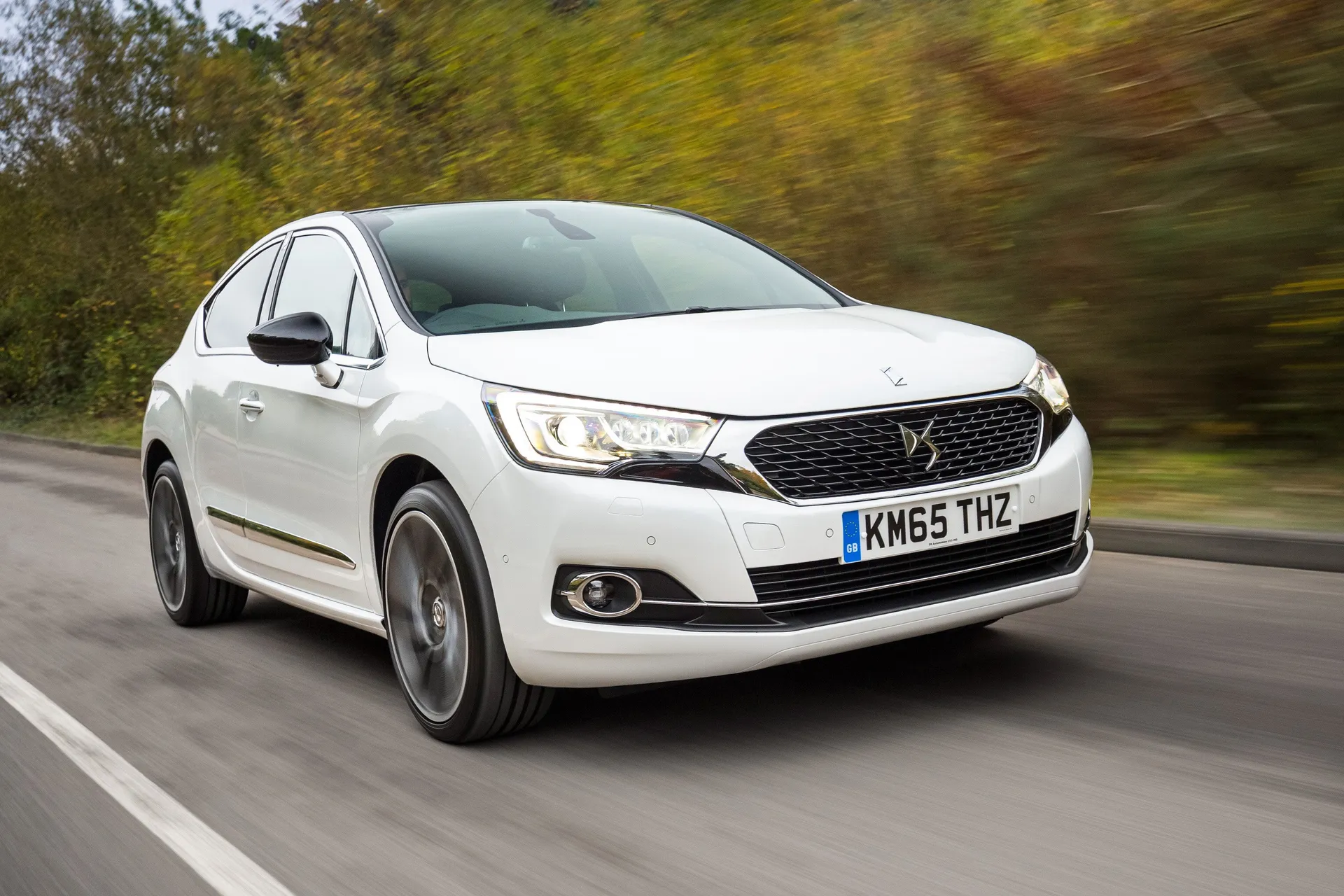
The result is a car that feels more agile and eager than the Citroen C4, but ultimately falls short of the comfort you’d expect in a crossover, or the precision you’d want from a hatchback or coupe.
It’s far from uncomfortable – the cabin quality plays a part in this – but the Citroen C4 Cactus outclasses the DS 4 here. Although the 19-inch alloy wheels look the part, we’d recommend the 18-inch rims if you’re after anything approaching a cushion-soft ride.
Overall, it’s a rather numb driving experience, which is a shame when you consider how much fun you can have behind the wheel of the smaller DS 3. The steering lacks feedback, but there’s little in the way of body-roll and a lorry-load of grip. It feels very French in this regard.
When DS waved goodbye to Citroen in 2015, it created two versions of the DS 4. The DS 4 Crossback was a direct response to the rise in popularity of compact crossovers, not to mention a signal of intent for the DS Automobiles brand.
The DS 4 Crossback is the more comfortable of the two, with the 30mm raised ride height helping to cushion you from all but the worst imperfections in the road, while giving you a commanding view of the road ahead.
In many ways, the Crossback is the version that manages to capture the essence of the DS brand. It’s more mature, more grown-up and somehow more upmarket.
What engines and gearboxes are available in the DS 4?
The Citroen DS 4 launched in 2011 with three petrol engines co-developed with BMW, plus a choice of two diesel units. The 1.6-litre VTi 120 petrol was mated to a five-speed gearbox, the 1.6-litre turbocharged THP 160 petrol got a six-speed automatic, while the flagship THP 200 petrol got a six-speed manual.
Of these, we’d recommend the THP 200, as it offers a terrific turn of pace and reasonable fuel economy. It helps the DS 4 to hit a top speed of 146mph, with a 0-62mph time of 8.5 seconds.
The VTi 120 is let down by the five-speed ‘box, which is a pain on the motorway, while the THP 160 is hamstrung by a woeful automatic transmission.
We’d have no problem recommending the 1.6-litre HDi 110 and 2.0-litre HDi 160 diesel engines, not least because they both get a six-speed gearbox. Unfortunately, the 1.6-litre e-HDi 110 Airdream is held back by an automatic transmission, which blunts performance and economy.
The revised DS 4 debuted in 2015 with an excellent 1.2-litre PureTech 120 petrol engine. It’s nine percent more powerful, provides 44 percent more torque, and is 21 percent more efficient than the old VTi 120, making it our choice of engine.
Other engines include a THP 165 with an EAT6 automatic transmission and a THP 210 with a six-speed manual gearbox, although the latter was dropped towards the end of DS 4 production. Of the diesel engines, the 2.0-litre BlueHDi 180 is a little disappointing, so we’d opt for the 1.6-litre BlueHDi 120.
Refinement and noise levels
The DS 4 feels so much more refined than the Citroen C4. In fact, we’d say that the DS 4 edges into premium territory.
Soundproofing under the bonnet ensures that little in the way of engine noise enters the cabin, while work on the door seals ensures outside noises are kept to a minimum. The work can only go so far, so there’s a fair amount of wind noise at motorway speeds. In fairness, it’s no worse in the DS 4 than other cars at this end of the market.
A petrol engine with a six-speed manual gearbox will deliver the greatest feeling of refinement. In sixth gear the engines settle down to a quiet hum at motorway speeds, and there’s none of the frustrating lethargy associated with the automatic transmission. In a similar fashion, DS 4 models fitted with a manual gearbox can feel noisy on the motorway – you’ll be pleading for a sixth gear.
Safety equipment: How safe is the DS 4?
The Citroen DS 4 was awarded a maximum five-star safety rating when it was crash-tested by Euro NCAP in 2011. It scored an impressive 97 percent for safety assist. This was the joint-highest rating of 2011, with the DS 4 sharing honours with the DS 5 and Peugeot 508.
The other scores were 90 percent for adult occupant protection, 80 percent for child occupant protection, and 43 percent for pedestrian safety.
Today, the DS 4 looks a little out of touch when many cars feature the latest range of driver assistance systems. Blind-spot monitoring is only standard on top trim levels, and optional on others (although not available on entry-level models).
Standard features on the Citroen DS 4 include six airbags, emergency braking assistance, intelligent traction control, hill-start assist and two ISOFIX points. The DSport trim also featured Citroen’s eTouch emergency and assistance systems.
The list of safety features is largely the same on the revised version introduced in 2015, but a reversing camera was introduced on some models. This is much needed, because the huge rear pillars and small rear window combine to make parking a game of chance. The Citroen eTouch emergency and assistance system – renamed DS Connect Box – was made standard across the range.
MPG and fuel costs: What does a DS 4 cost to run?
"Both the Citroen DS 4 and DS 4 versions are powered by a range of efficient petrol and diesel engines. For example, the old 1.6-litre HDi 110 diesel engine offered a claimed 70.6mpg on a combined cycle when paired with a manual gearbox, falling to 68.9mpg with the automatic transmission."
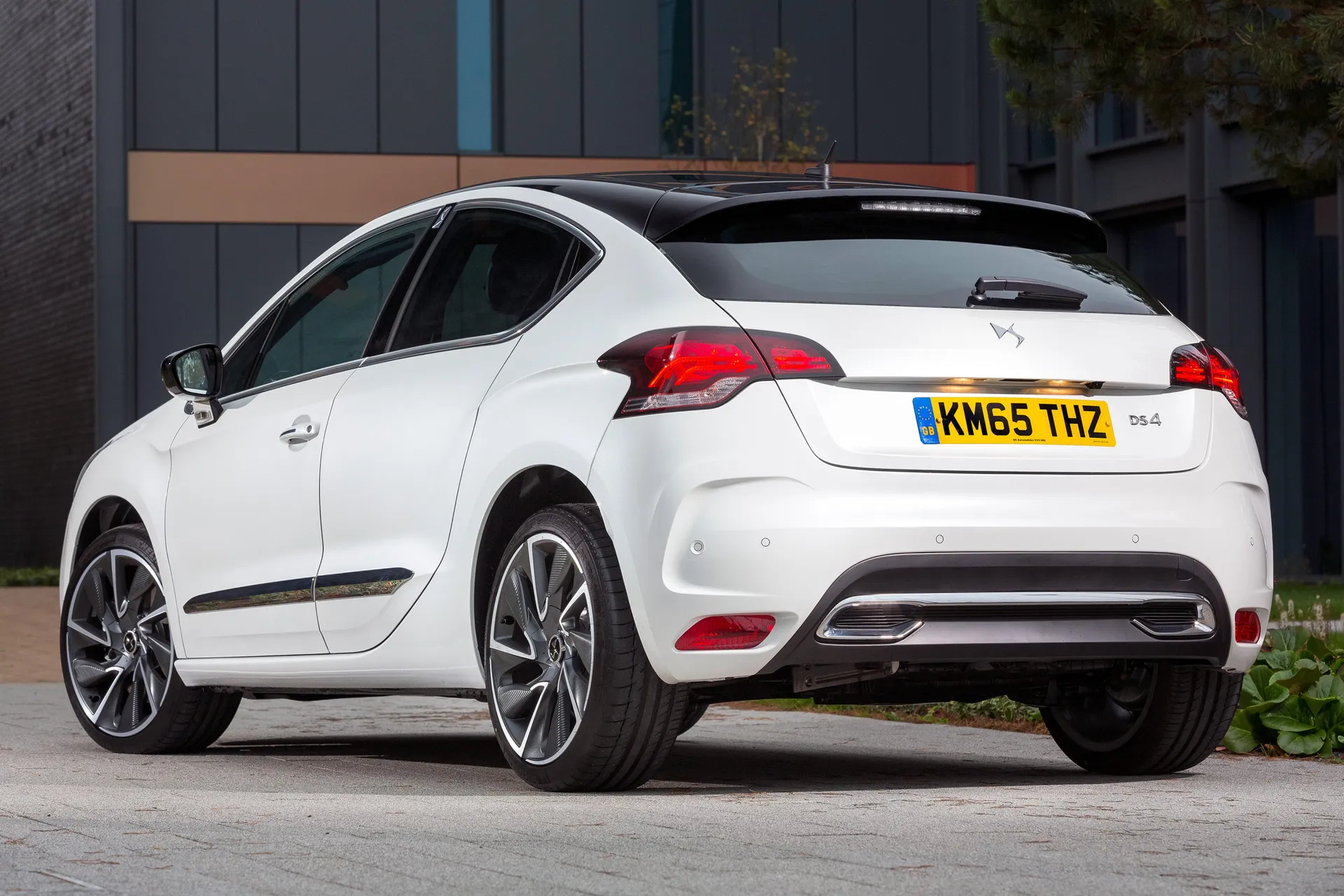
The BlueHDi 120 in the DS 4 and DS 4 Crossback offered as much as 74.3mpg, but it’s worth noting that all DS 4 figures are based on the old NEDC test, rather than the more reliable WLTP cycle (now standardised for new cars).
How reliable is a DS 4?
The DS 4 received a modest 9.00 out of 10 for reliability in the HonestJohn.co.uk Satisfaction Survey, although it is worth bearing in mind that not a huge number were sold in the UK so the sample size is relatively small.
Possibly more representative is the fact the Citroen brand finished 25th out of 30 manufacturers in the overall ratings, which not what you could call a strong showing.
Insurance groups and costs
The cost of insurance on the Citroen DS 4 varies considerably depending on engine size and specification. For example, the DSport 1.6 THP 200 slots into group 31, which means getting cover is going to be expensive for young drivers. Other versions are less costly, but the group ratings still range from 17 to 28.
To provide some context, the groups for the standard Citroen C4 range from 12 to 29. Insurance for the DS 4 is roughly in line with the Citroen version, with groups ranging from 18 to 31. The DS 4 Crossback slots into groups 21 to 32.
VED car tax: What is the annual road tax on a DS 4?
For a DS 4 registered on or after 1 April 2017, the rate of Vehicle Excise Duty (VED) is £165 a year, regardless of the engine or emissions.
For a DS 4 or Citroen DS 4 registered on or before 31 March 2017, the rate varies according to CO2 emissions. The cheapest is the Citroen DS 4 with the e-HDi 110 Airdream EGS6 engine and transmission, which costs £30 a year to tax.
At the opposite end of the spectrum, the Citroen DS 4 THP 160 manual costs £165 a year. The majority of DS 4 and DS 4 Crossback models registered before the end of March 2017 cost between £20 and £30 to tax, but there are a couple of exceptions.
How much should you be paying for a used DS 4?
If you’re after a DS 4 without the Citroen badge, you’ll need to part with at least £8,000. This is enough to secure a 2017 car with around 60,000 miles on the clock. A late 2018 DS 4 will cost up to £12,500, which is excellent value for money when you consider that the cars cost £21,355 to £26,405 before DS pulled the plug.
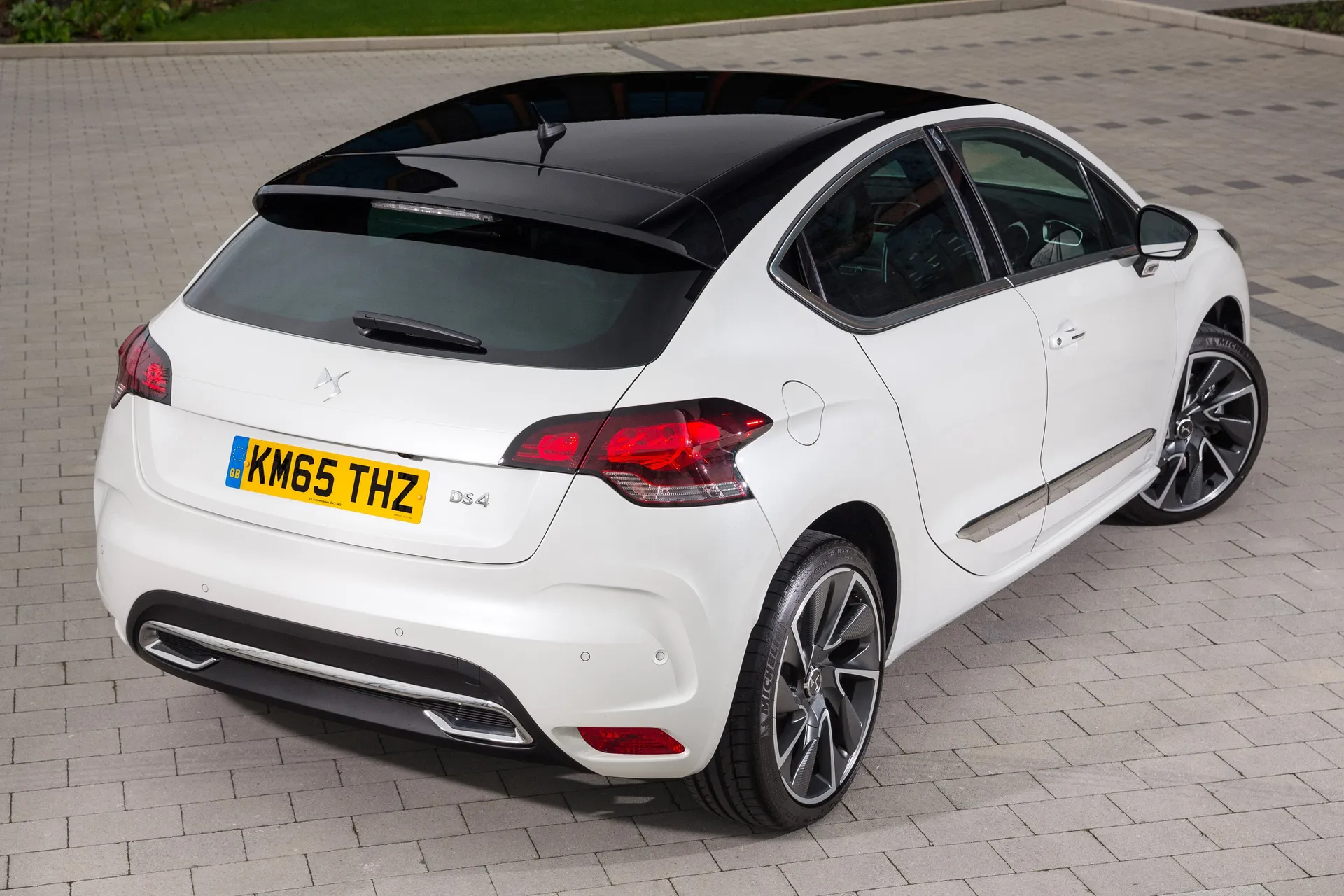
Because the DS 4 Crossback wasn’t introduced until 2015, you’ll need to spend at least £8,000 to secure one of the earliest examples. A late Crossback will cost roughly the same as the standard DS 4, but you’ll pay a premium for the flagship Terre Rouge edition.
Trim levels and standard equipment
The Citroen DS 4 launched with three trim levels: DSign, DStyle and DSport. The entry-level Citroen DS4 DSign features 17-inch alloy wheels, leather steering wheel with chrome inserts, cruise control, air conditioning, multi-function steering wheel, dark tinted rear side and tailgate windows, front fog lights with cornering function and a radio/CD player with six speakers.
Upgrading to the Citroen DS 4 DStyle adds LED interior mood lighting, 18-inch alloy wheels, rear parking sensors, dual-zone climate control, leather and cloth upholstery, front seats with electric lumbar adjustment and massage function, plus automatic lights and wipers. The flagship Citroen DS 4 DSport boasts heated full leather seats, 19-inch alloy wheels and front parking sensors.
The trim levels changed as part of the rebrand, with the entry-level trim now called Elegance. There was also a sporty DS 4 Performance Line, a luxurious DS 4 Prestige, plus the DS 4 Crossback, the latter of which could be ordered in lavish DS4 Crossback Moondust or Terre Rouge trim.
Ask the heycar experts: common questions
What is a DS 4?
How much is a DS 4?
Is DS 4 an SUV?
Get our latest advice, news and offers
Keep me updated by email with the latest advice, news and offers from heycar.
By submitting you agree to our privacy policy
